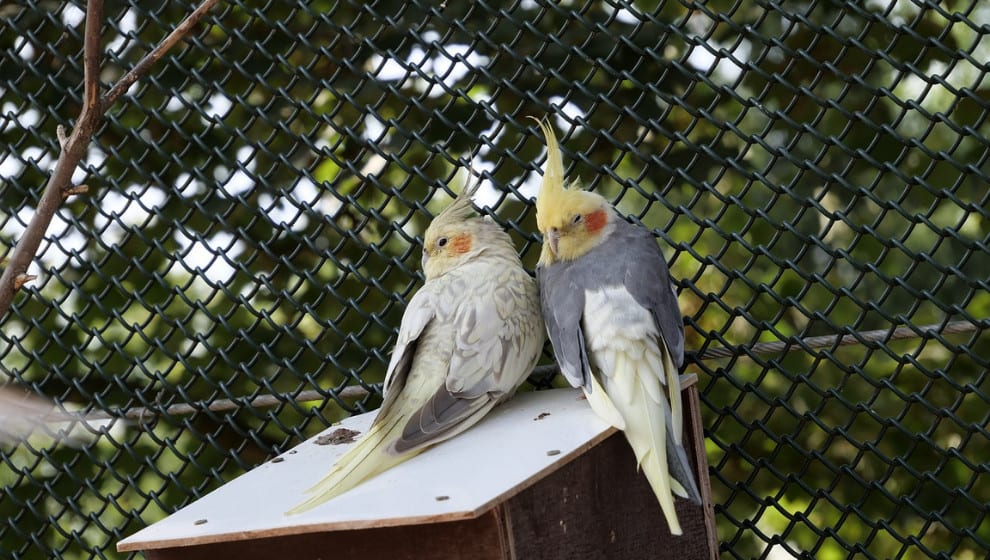Birds are the most lovable creatures of nature. They give a warm sense of feeling when it comes to witnessing their flight. Yes, the way they set them free in the air is one of the emblems of hope and glory. One of the most attractive flights taking birds is a cockatiel. There are various species of the cockatiel. They are one of the friendliest kinds, and hence, they are ideally kept as pets. They have simple habits, and therefore they are pretty easy to manage and maintain.
The sound they produce is something very appealing. If you are planning to choose them as your pet, there are several reasons why you must try to enjoy their presence in your home. Check it out.

Before you rush to fetch them from the shop, make sure you know every important detail about them. This will help you to engage with your cockatiel in a better way. Moreover, once you know about their habits, you will indeed find out why you must love them unconditionally. Let’s start.
Table of Contents
Do Cockatiels Moult?
Moulting is a process to which many animals and birds undergo. The animal sheds its skin or feathers and sooner attains the firm and new fur or feather. This moulting process occurs on an annual basis in most cases. Still, some on the birds and animals undergo moulting twice a year.
When it comes to cockatiel, keeping up with all the unique features, they also undergo the moulting process. During this process, they shed all of their feathers and stretch out their body completely. In this case, you can easily witness them growing bit by bit. For sure, it seems to be appealing. Moreover, if you want to sustain your cockatiel’s health during moulting, try to take a little more care because their bodies are all exposed. Their bodies become photosensitive. Therefore, try to avoid exposing them to sunlight.
When Do Cockatiels First Moult?
For sure, moulting is a unique process to which nearly all birds undergo. The moulting patterns are dependent on individual bird species along with several other influencing factors. For the first time, when cockatiel undergoes moulting, it’s at the age of 6 to 9 months. Surprisingly, they are not very young at this time. Instead, they are about to hit adulthood.
The first moulting sometimes turns out to be a little hectic for birds, and it may leave them more irritating. In any such a case, try to be gentler towards your cockatiel. Show them as much affection as you could. For the first moulting, offer them a protein-rich diet that could help them regrow their feathers quickly.
When Does Adult Cockatiels Moult?
Mostly, the owners claim that they witness a slight change in cockatiel activities as soon as they hit adulthood. This sometimes includes their behaviours and even their energy levels. Especially if you have been keeping a cockatiel since its birth, it turns pretty friendly and familiar with you till its maturity. The mutual understanding will be far more at this age, and if you train them well, you will find them following your instructions with all of their interests. Isn’t it amazing? Yes, for sure.
When we talk about cockatiel adult moulting, they initiate their adult moult when they are 6-12 months old. This age is variable, which depends on the animal’s physical state and even the weather. Cockatiel takes warmer weather as a trigger to start the moulting procedure. It undergoes this moulting biannually, with which it begins its full-fledged growth. It’s certainly something unique to witness in your bird that it is growing smartly with time.
How Often Do Cockatiels Moult?
Moulting sometimes causes hidden stress in birds. This starts the change in their eating and sleeping habits. Many times, they develop photo sensitivities to which you must pay adequate attention. The ideal way to support your cockatiel during its moulting is to offer them a good diet that is based on protein. You may add multivitamin supplements and keep them hydrated enough to bear the heat exposure. Mainly, moulting occurs in warm weather. Hence, the loss of body moisture is quite evident in this case.
As we already have discussed, cockatiel first moults between 6-9 months of age; you might wonder about the frequency of this process. That’s quite crucial, and as a pet owner, you must know this so that you could manage to cater to them well meanwhile. Basically, after shedding their feathers for the first time, they undergo a heavy shedding process two times a year, along with a light shedding casually during months. You don’t need an alarm to get notified, as you can quickly notice it. You may find irregular flakes and feathers all around and witness the bird preening often. For sure, in this situation, your cockatiel will not look that much attractive. Mainly, you have to wait for a little more as the feather replacement is not as quick as magic.
Cockatiel’s Moulting Process
The cockatiel moulting process is not as complex as some birds. Once you note their patterns, it will be relatively more manageable for you to treat them as they start to shed their feathers. It must be kept in mind that you will notice the first heavy fall of feathers at 6-9 months. At this time, if you keep up with a good diet and offer them a little extra care, they will continue to grow better and healthier.
Looking at the process, it’s about the growth of early blood feathers. They are called blood feathers because of the maintained blood supply, which ensures adequate nourishment. Once the feathers are formed completely, the blood supply to the shaft of feathers stops. You, as an owner, should keep this in mind that these blood feathers must never be pulled out unless it breaks down on its own. In this scenario, the shaft which is broken down act like a straw, and the blood supply will not be stopped unless the remaining feather drops down. Sometimes, if the feather outgrows, the blood supply is minimal, and therefore it may clot. Yet, the broken feather must be removed carefully. This issue only arises with tail and wing feathers. This is because the body feathers do not have large shafts.
It often supports the bird to clean and groom their pin feathers, mainly around their head region. These are specialized feathers that have not been removed from their safety coating. They are based on a wax-like appearance with prominent spikes. A bird faces trouble in grooming these on the head, and therefore, it’s your chance to roll your fingers gently to help the waxy coat fall off. If you find that the pin feathers are still new, the bird will surely react as they feel it.
Cockatiel Behavior During Moulting
Moulting is regarded as one of the most crucial stages of animals’ life. When it comes to the cockatiel reactions and behaviour during this period, you will be amazed to know that they don’t show any severe tantrums like other birds. But, of course, since the process is quite painful, you may witness some behavioural changes in your bird. Although any bird does not give off all of its feathers together but still, this time of the year is quite disturbing for the bird. Its defense mechanism turns weak, and it appears to be quite an easy target for predators.

French Moult
French moult is a condition that is sometimes witnessed in cockatiel as well. This occurs mainly when they undergo stress injuries during early life due to a death in their nest. It is regarded as a disease state which is characterized by bruising and abnormal development of feathers. The condition is also reported in other birds like lovebirds or various psittacine species. If you see something like this in your cockatiel, try to calm down your bird and connect to a veterinarian to know the condition and start the management under experts’ supervision.
Abnormal Moult
Sometimes, it is found that the bird is having an abnormal moulting process in them. During this, sometimes, the color of their feather variate and turns dull. In any case, if these feathers are broken down, the bird faces stress, and they fail to grow like expected trends. If your cockatiel turns sick, it will fail to moult as it does in normal conditions. Therefore, you must pay adequate attention and take it seriously. Try to get a checkup with experts to avoid any mishap with your beloved bird.
What Should You Do When Your Cockatiel Is Moulting?
As we have already discussed that your cockatiel will be under stress when it undergoes moulting. You may face some changes in their behavioural patterns. However, you, as the owner, must pay attention to bring ease as much as possible. After all, the bird enjoys your affection.
The first thing to keep in mind is diet. You must maintain a proper diet along with some extra vitamins. This is important because you can help them to grow sufficiently by this. Also, try to give them fresh vegetables and fruits in the form of chunks. Keep up with the fresh water supply and maintain hygiene as much as you could. You may give egg whites to them as protein-based diet can help your cockatiel to grow better and fast.
Secondly, the head scratches are important. Still, they face problems in clearing the head and neck areas. You can help them with gentle fingering on these areas. This allows them to ease their itchiness quite quickly. The loose form of keratin sheaths is simple enough to be scraped off.
The third thing that you must try for your pet is the bath. You can give them baths in the dish with a sufficient amount of water. You may slightly mist over with spray. This helps in relaxing the bird during this crucial period. As mentioned earlier, the bird faces a lot of stress and feels unsafe. Try to cover an area of the cage with a hood to offer a shadow. This will calm them down as they turn photosensitive sometimes because of losing feathers. The warmth of love and affection is the key to help your cockatiel feel safe during moulting. Also, the incubating heat is good enough for the bird to feel relax in every way.
Wrapping Up
The cockatiel is undoubtedly the most lovable creature that you would ever see. These birds have fabulous feathers with various colors that are good enough to make them attractive. No matter how much you want to keep your bird away from moulting and its consequences, you cannot because it is a natural phenomenon and is much needed for your bird to grow well. All you can do is love your cockatiel unconditionally and support them during moulting. Your warm gestures are all what is much needed to help them pass this stage. Once they are done with moulting, you can again enjoy with your cockatiel.

Hey, I am a licenced veterinary practitioner. Since my childhood, I have always dreamed to be a vet and play with these adorable creatures all day long. My love to write and spread awareness pushed me towards blogging. So, I decided to merge both of my passions and create highly knowledgeable blogs for the people struggling with their new pets. There are multiple cases you may face with your pets in everyday life and also multiple odd behaviours may pop hundreds of questions into your mind. Every behaviour has a reason, and I am here to provide the very logical reasons and easy solutions. Let us take care of our pets in the best possible way!

